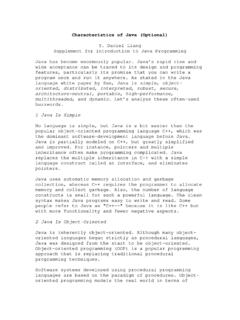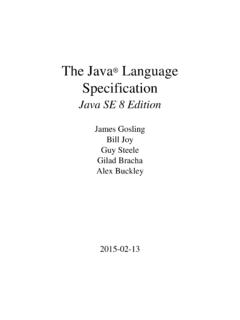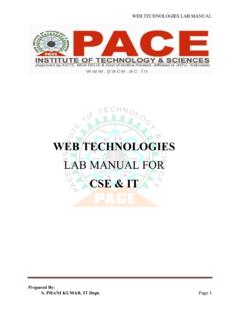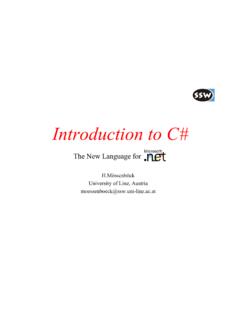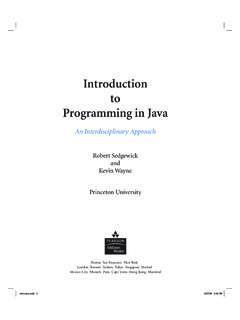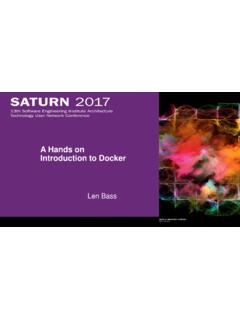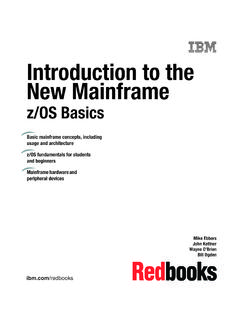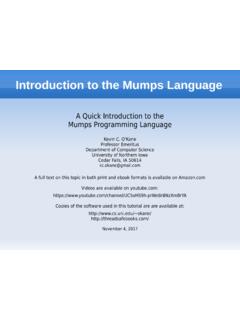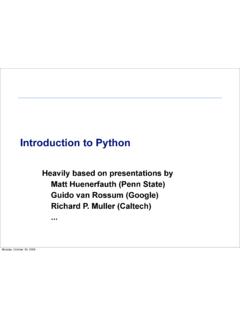Transcription of Java, Java, Java - Computer Science
1 java , java , JavaObject-Oriented Problem SolvingThird EditionR. Morelli and R. WaldeTrinity CollegeHartford, CTJune 25, 2017 This work is licensed under aCreative Commons Attribution International License (CC BY ).This book was previously published byPearson Education, to the Open SourceEditionJava, java , java , 3ewas previously published by Pearson Education, first edition (2000) and the second edition (2003) were published byPrentice-Hall. In 2010 Pearson Education, Inc. reassigned the copyright tothe authors, and we are happy now to be able to make the book availableunder an open source PDF edition of the book is available under a Creative CommonsAttribution International License, which allows the book to be used,modified, and shared with attribution:( ).
2 Ralph Morelli and Ralph Walde Hartford, CT December 30, 2016iiiPreface to the Third EditionWe have designed this third edition ofJava, java , Javato be suitable fora typical introduction to Computer Science (CS1) course or for a slightlymore advanced java as a Second Language course. This edition retains the objects first approach to programming and problem solving that wascharacteristic of the first two editions. Throughout the text we emphasizecareful coverage of java language features, introductory programmingconcepts, and object-oriented design third edition retains many of the features of the first two editions,including: Early introduction of Objects Emphasis on Object Oriented Design (OOD) Unified Modeling Language (UML) Diagrams Self-study Exercises with Answers Programming, Debugging, and Design Tips.
3 From the java LibrarySections Object-Oriented DesignSections End-of-Chapter Exercises Companion Web Site, with Power Points and other ResourcesTheIn the Laboratorysections from the first two editions have been movedonto the book s Companion Web Site. Table 1 shows the Table of Contentsfor the third s New in the Third EditionThe third edition has the following substantive changes: Although the book retains its emphasis on a running example that is revisited in several chapters, the CyberPet examples havebeen replaced with a collection of games and puzzle examples. TheCyberPet examples from earlier editions will be available on theCompanion Web 1: Table of Contents for the Third 0 Computers, Objects, and java (revised)Chapter 1 java Program Design and DevelopmentChapter 2 Objects: Defining, Creating, and UsingChapter 3 Methods: Communicating with Objects (revised)Chapter 4 Input/Output: Designing the User Interface (new)Chapter 5 java Data and OperatorsChapter 6 Control StructuresChapter 7 Strings and String ProcessingChapter 8 Inheritance and Polymorphism (new)Chapter 9 Arrays and Array ProcessingChapter 10 Exceptions.
4 When Things Go WrongChapter 11 Files and StreamsChapter 12 Recursive Problem SolvingChapter 13 Graphical User InterfacesChapter 14 Threads and Concurrent ProgrammingChapter 15 Sockets and Networking (expanded)Chapter 16 Data Structures: Lists, Stacks, andQueues (revised and expanded) Chapters 0 (Computers, Objects, and java ) and 1 ( java Program De-sign and Development) have been substantially reorganized andrewritten. The new presentation is designed to reduce the pacewith which new concepts are introduced. The treatment of object-oriented (OO) and UML concepts has also been simplified, and someof the more challenging OO topics, such as polymorphism, havebeen moved to a new Chapter 8.
5 The new java is introduced in Chapter 2 and isused to perform simple input operations. Chapter 4 (Input/Output: Designing the User Interface) has beencompletely written. Rather than relying primarily on applet inter-faces, as in the second edition, this new chapter provides indepen-dent introductions to both a command-line interface and a graphi-cal user interface (GUI). Instructors can choose the type of interfacethat best suits their teaching style. The command-line interface isbased on theBufferedReaderclass and is used throughout therest of the text. The GUI is designed to work with either graphi-cal applications or applets.
6 Both approaches are carefully presentedto highlight the fundamentals of user-interface design. The chapterconcludes with an optional section that introduces file I/O using thenewScannerclass. Much of the discussion of inheritance and polymorphism, whichwas previously woven through the first five chapters in the secondedition, has been integrated into a new Chapter 8. An optionalgraphics trackis woven throughout the text. Beginningwith simple examples in Chapters 1 and 2, this track also includesvsome of the examples that were previously presented in Chapter 10of the second edition. Chapter 15, on Sockets and Networking, is expanded to cover someof the more advanced java technologies that have emerged, includ-ing servlets and java Server Pages.
7 Chapter 16, on Data Structures, has been refocused on how to usedata structures. It makes greater use of java s Collection Framework,including theLinkedListandStackclasses and theListinter-face. It has been expanded to cover some advanced data structures,such as sets, maps, and binary search Essentials EditionAnEssentials Editionof the third edition, which will include Chapters 0-12, will be published as a separate title. The Essentials Edition will coverthose topics (Chapters 0-9) that are covered in almost all introductory(CS1) courses, but it will also include topics (Exceptions, File I/O, andRecursion) that many CS1 instructors have Start with Objects?
8 The Third Edition still takes anobjects-earlyapproach to teaching Java, with the assumption that teaching beginners the big picture early givesthem more time to master the principles of object-oriented approach seems now to have gained in popularity as more and moreinstructors have begun to appreciate the advantages of the Orientation (OO) is a fundamental problem solving and designconcept, not just another language detail that should be relegated to themiddle or the end of the book (or course). If OO concepts are introducedlate, it is much too easy to skip over them when push comes to shove inthe first time I taught java in our CS1 course I followed the same ap-proach I had been taking in teaching C and C++ namely, start with thebasic language features and structured programming concepts and then,somewhere around midterm, introduce object orientation.
9 This approachwas familiar, for it was one taken in most of the textbooks then availablein both java and C++.One problem with this approach was that many students failed to getthe big picture. They could understand loops, if-else constructs, and arith-metic expressions, but they had difficulty decomposing a programmingproblem into a well-organized java program. Also, it seemed that thisprocedural approach failed to take advantage of the strengths of java sobject orientation. Why teach an object-oriented language if you re goingto treat it like C or Pascal?I was reminded of a similar situation that existed when Pascal was thepredominant CS1 language.
10 Back then the main hurdle for beginners wasprocedural abstraction learning the basic mechanisms of procedure callviand parameter passing and learning how todesignprograms as a collec-tion of ! Pascal!, my favorite introductory text, was typicalof a procedures early approach. It covered procedures and parametersin Chapter 2, right after covering the assignment and I/O constructs inChapter 1. It then covered program design and organization in Chap-ter 3. It didn t get into loops, if-else, and other structured programmingconcepts until Chapter 4 and , the main hurdle for beginners is the concept ofobject programmers must be able to see a program as a collection ofinteracting objects and must learn how to decompose programming prob-lems into well-designed objects.
